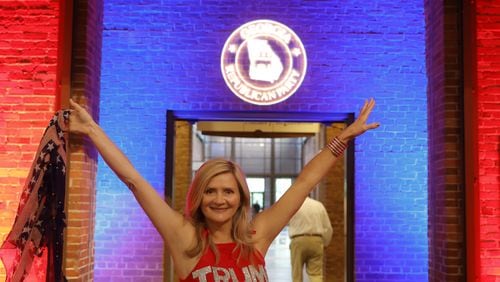Georgia and South Carolina port projects
A massive project to deepen the Savannah River leading to the city’s port is currently underway. Charleston seeks final federal approval for its deepening project.
- Savannah's project is expected to be finished by 2020 at a cost of $706 million. Georgia still needs $400 million from the federal government to pay for the project.
- Work at the Port of Charleston is also expected to be completed by 2020 at a cost of $509 million. South Carolina has already set aside $343 million for the project. It needs $166 million from the federal government.
- Georgia and South Carolina plan to combine efforts to build a $4.5 billion port, the Jasper Ocean Terminal, downriver from Savannah. It is tentatively scheduled to open in 2028.
Note: All dates tentative.
Source: Georgia and South Carolina port authorities
Story highlights:
- Georgia and South Carolina plan to work together in building a $4.5 billion port downriver from Savannah that is projected to open in 2028.
- One former Georgia ports official says the plan to build what is currently called the Jasper Ocean Terminal offers the two states "an opportunity to build the most modern port in the world."
- One study predicts it will create hundreds of jobs and $210 million in annual wages.
- Environmental groups have raised concerns about further deepening the Savannah River for the Jasper project, while an official from a taxpayer group says it will likely be harder in the future to get the kind of federal money these types of projects usually attract.
- Before Georgia and South Carolina can get started on the Jasper project, both are currently working to deepen existing ports in Savannah and Charleston to handle larger container ships. Each of those projects is still in need of hundreds of millions of dollars from the federal government.
Georgia and South Carolina officials will soon start a lengthy regulatory journey toward the construction of a $4.5 billion port along a barren stretch of the Savannah River intended to handle global trade into the 22nd century.
But first, each state must finish — and pay for — massive port-deepening projects in Savannah and Charleston. And they must leave behind decades of animus and bistate rivalry that threatened Savannah’s future as the Southeastern gateway for international trade.
A dredge, The Alaska, began deepening the Savannah River this week, a major step toward completion of the $706 million project by 2020. Charleston awaits final federal approval for a half-billion-dollar dredging project also scheduled for completion by then.
Yet Georgia still needs $400 million from Washington to finish its deepening. Charleston requires $166 million.
Once those projects are completed, port and state officials will turn their attention toward securing, at first, $2 billion for the joint port, the so-called Jasper Ocean Terminal. They are expected to request an environmental permit from federal officials this fall.
The proposed 1,500-acre port on the South Carolina side of the river will take at least 13 years to build, an eternity in international commerce. Predicting continued growth in imports and exports is risky, as is relying on China to keep sending packed container ships to the Southeast.
Shipping lines and their customers determine which ports to use and when, further muddying the economic feasibility of a long-off port. Shippers may abandon the Port of Savannah — a longer, costlier cruise upriver — for Jasper, a maritime shift that could cost the Georgia Ports Authority millions of dollars.
And, despite assurances that a Jasper port would be mutually beneficial, bad blood between the two states could overshadow its hoped-for success.
“I wouldn’t be surprised to see some of that acrimony as to who is the main beneficiary, how are the costs allocated and does one state feel it’s not getting as much benefit as the other,” said Steve Ellis, a vice president with Taxpayers for Common Sense, a nonprofit fiscal watchdog in Washington. “And it’s not like there is a lack of port-deepening projects on the East Coast. Somebody is going to be a loser, and we’ll have a white elephant on our hands.”
Atlanta’s Jim Balloun, a former chairman of the Jasper port board, said it would be folly not to plan for a surge in container traffic, especially with the ports of Savannah and Charleston expected to run out of room in 15 years.
“Jasper gives us an opportunity to build the most modern port in the world, so it will be extremely cost-competitive with any other port,” he said. “This project will be very beneficial to the citizens of South Carolina and Georgia. We need to prepare ourselves today.”
‘A lot of stuff still to figure out’
The Zim Tarragona and the Maersk Wolfsburg, container ships steaming, respectively, to and from the Port of Savannah, dwarf the Boston Whaler piloted by Jason Ball. He idled the engine one recent cloudy morning to let pass the megaships. Just beyond, on the other side of the Savannah River, sat South Carolina and the 4.5-mile stretch of barren shoreline where the Jasper port may be built.
Ball, 39 and a maritime engineer, hunted for shark’s teeth along the banks of the proposed port as a kid. Today, he’s the top technical guy for the joint port that could one day berth ships at Jasper carrying twice as many containers as the Wolfsburg.
The Georgia Department of Transportation once owned the land in Jasper County, but it deeded the property in 2008 to the Georgia and South Carolina port authorities. Nine million cubic yards of mud will be scooped from the river bottom as part of the Army Corps of Engineers’ plan to deepen the channel to 47 feet. Much of the muck will be deposited on the Jasper site, a cost-saving move that will firm up the ground under the future terminal.
A report released last month by Ball’s engineering firm, Moffatt & Nichol, says the federal government will take eight years to study the Jasper port’s economic and environmental feasibility. Engineers will determine whether the river can go as deep as 54 feet. Construction of the terminal, four-lane road and two rail lines would take an additional five years.
The site sits almost 10 miles from a paved road. It is surrounded by swamp, bird sanctuaries, the river and the Intracoastal Waterway. Wild hogs, alligators and snakes hide amid the wax myrtles and marsh grass.
“There’s a lot of stuff still to figure out. But it’s an opportunity to unify the Southeast and bring two bitter rivals together,” Ball said as an occasional dolphin swam by.
Jasper — envisioned as large as Savannah’s Garden City Terminal — could handle 7 million containers a year; Garden City turned 3.7 million containers last year. Charleston did about half as many.
One study predicts hundreds of new jobs and $210 million in annual wages, an enticing economic impact for one of the poorest corners of South Carolina.
“We’re not suffering for a lot of jobs, but they’re not high-paying jobs,” said Bronco Bostick, the mayor of nearby Hardeeville, S.C. “Anytime you can make $14, $16, $19 an hour, that beats the minimum wage. It would bring a lot of opportunity to the Low Country.”
Savannah is the nation’s fourth-busiest port; Charleston is the nation’s ninth. By 2030, though, each will likely run out of room for the steel containers.
“Over the last 50 years, the container business has grown twice as fast as GDP,” said David Posek, the chairman of the Jasper port board. “As the shipping lines move to these larger ships, Jasper allows us to be the megaship container port on the East Coast.”
Environmentalists, though, who fought the river’s current deepening, can’t fathom further degradation of the Savannah River. Nearly half of the $706 million price tag for the current deepening will go to mitigate the damage expected from dredging 41 miles of river. Opponents preferred that the river only be deepened to the Jasper site.
“The river needs to stay at 47 feet,” said Tonya Bonitatibus, the Savannah Riverkeeper. “There is an aquifer right there, really close to 47 feet. It would also have a pretty significant effect on Tybee Island. My initial impression is that we will fight additional deepening pretty strongly.”
Financing remains a bit uncertain
Georgia and South Carolina taxpayers have already ponied up money for their port projects: $266 million for the Savannah River; $343 million for Charleston’s harbor. Each, though, needs major financial help from Washington and a tight-fisted Congress to complete the projects.
Balloun, who also served on the Georgia Ports Authority board, expects the feds to finance the remaining $400 million to deepen the river. He and South Carolina’s Posek also predict Washington will continue to honor its traditional 70-30 financial arrangement for the construction of port projects well into the future.
If true, Georgia and South Carolina will each need to come up with roughly $300 million for their shares of the $2 billion Jasper port’s first construction phase. Ellis, with the taxpayer group, says don’t count on Washington to keep plowing money into two regional ports within 75 nautical miles of each other.
“There are limited dollars for this type of investment and a lot of demand around the country,” he said. “It’ll be more and more competitive to get these deepening dollars, particularly if they want to go a lot deeper with the port of Jasper.”
Jasper board members, along with Moffat & Nichol, will study various public and private financing scenarios, including port-revenue-backed bonds and direct taxpayer assistance. But paying for the remaining $2.5 billion will get even trickier. Balloun and Posek suggested the bond markets, as well as private investors, will be considered. Tapping the hoped-for healthy revenues of the ports of Charleston and Savannah might also help build Jasper.
“By the time we get around to that we will have demonstrated that Jasper is a real moneymaker that will generate cash flow and show that it is competitive so that people will want to put more money behind it,” Balloun said.
Any financial arrangement, though, depends upon goodwill between the once-warring states, an uneasy assumption given bistate disputes the past 20 years over Southeastern port supremacy. Jasper County twice tried, unsuccessfully, to condemn the site to gain ownership. South Carolina politicians also tried to slow the deepening to keep Charleston’s port from falling further behind Savannah.
Finally, in 2006, the states’ governors tried to bury the hatchet by establishing the joint port office. Five years later, though, South Carolina officials withheld money for the project, claiming the folly of deepening the river to only 47 feet when a Jasper port would need much deeper water.
“I don’t think before there was an earnest effort to build the Jasper Ocean Terminal,” said South Carolina state Sen. Larry Grooms, a Charleston Republican who serves as chairman of the Transportation Committee. “With any business deal, it only works if both parties benefit. I believe now that it is in both states’ mutual interest to build it.”
About the Author






